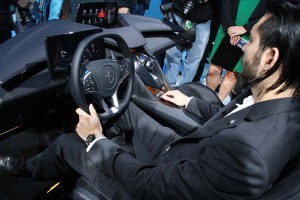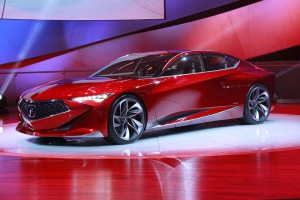
Acura carried on its "Precision" design exercise from the Detroit show last January in Los Angeles with the Precision Cockpit.
Japanese luxury brand Acura pressed the design boundaries when it revealed its Precision Concept vehicle at the Detroit Auto Show last January. As the new auto show season gets underway, Acura is going from outside in, giving us a look at what tomorrow’s automotive interior might look like as key trends like electrification, connected tech and autonomous driving take hold.
Meant to complement the edgy Precision Concept vehicle, the Acura Precision Cockpit debuting at the Los Angeles Auto Show is not just sportier than the typical vehicle interior but adopts a more high-tech, touchpad-based approach to controlling vehicle functions.
“Absolute positioning transforms the touchpad experience, making it personal, intuitive and particularly well-suited for premium, driver-centric, performance machines,” said Dave Marek, Acura’s executive creative director. “It’s also designed to be quickly and easily adopted, as drivers become acclimated and comfortable in minutes.”
How much change we’ll see in automotive interiors is a matter of much debate and likely depends on several key trends. A look at what some competitors are doing provides a few hints. The new Jaguar I-Pace Concept, also debuting at the L.A. Auto Show moves batteries and key components under the load floor, allowing the cabin to move forward and creating far more space for occupants.
(Kia puts a little zip into the new Soul. Click Here for the story.)
The Mercedes-Benz F015 show car assumes autonomous vehicles will allow the cabin to be transformed into a mobile living room. The Rolls-Royce Vision Next 100 eliminates the steering wheel and pedals, essentially becoming a mobile screening room, with a huge videoscreen in place of a traditional instrument panel.
Acura doesn’t take things quite so far. It still assumes drivers will want the option of sporty driving, even if they let the autonomous system take control on the morning commute. And the overall feel suggests Acura designers started off with the layout of the newly reborn NSX supercar in mind. They’ve also made sure that the concept interior retains a luxurious feel, with elegant materials like brushed metal, natural wood, leather and Alcantara, as well as a distinctive copper-amber LED lighting.
The centerpiece of the instrument panel is a reconfigurable, high-resolution 12.3-inch display. A smaller display summits the center stack, both meant to allow the driver to keep eyes on the road.
A curved touchpad, meanwhile, is positioned within easy reach on the center stack. The tablet-style system essentially replaces conventional buttons and switches. That’s likely to trigger some debate, of course. Acura and parent Honda have been active proponents of minimizing conventional controls. But the Japanese maker has waved a white flag with the debut of the new Honda CR-V – which reintroduces a volume control knob alongside the touch-based infotainment screen.

The Acura Precision Concept made its debut at the North American International Auto Show in Detroit. Photo credit: Len Katz.
(Click Here to see how Lexus is spicing up the L.A. Auto Show.)
The entire display and control package can be customized and it is designed to interact with the world around the vehicle. There is a real-time 3D engine, for example, that not only displays potential obstacles, whether other cars, bicycles or pedestrians, but also shows when a passing vehicle is operating autonomously. It can also use connected car systems to warn of oncoming vehicles and other obstacles out of sight.
To manage and interface with the large, reconfigurable display, the Precision Cockpit’s touchpad uses a high resolution mapping system, explains Marek.
The smaller, center stack display, meanwhile, runs an Android-based operating system that Acura claims can handle a mix of mobile apps, data and other content that can be divided into two separate zones for easier access. Navigation, it notes, always remains “front and center.”
The Japanese luxury marque also notes that the system is design to enhance cybersecurity, something that the National Highway Traffic Safety Administration has called one of the biggest threats the auto industry faces.
How much of the Acura Precision Concept will actually make it into production is far from certain. But there is little doubt that automotive interiors, and particularly vehicle displays and controls, will go through significant changes going forward.
(To see more about the finalists for the North American Car and Truck of the Year, Click Here.)
“Advances in electrification, automated vehicles and connectivity are fundamentally reshaping the future of mobility,” said Jon Ikeda, vice president and general manager of Acura. “Acura is determined to leverage this massive shift to deliver unique expressions of performance to our customers.”

